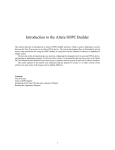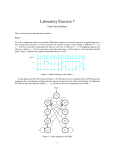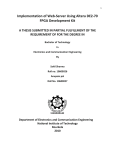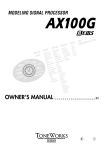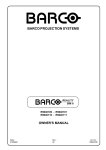Download Introduction to the Altera SOPC Builder Using VHDL Designs
Transcript
Introduction to the Altera SOPC
Builder Using VHDL Designs
1
Introduction
This tutorial presents an introduction to Altera’s SOPC Builder software, which is used to implement a system that
uses the Nios II processor on an Altera FPGA device. The system development flow is illustrated by giving stepby-step instructions for using the SOPC Builder in conjuction with the Quartus® II software to implement a simple
system. The last step in the development process involves configuring the designed circuit in an actual FPGA device,
and running an application program. To show how this is done, it is assumed that the user has access to an Altera
DE-series Development and Education board connected to a computer that has Quartus II and Nios® II software
installed. The screen captures in the tutorial were obtained using the Quartus II version 11.0; if other versions of the
software are used, some of the images may be slightly different.
Contents:
• Nios II System
• Altera’s SOPC Builder
• Integration of the Nios II System into a Quartus II Project
• Running the Application Program
Altera Corporation - University Program
May 2011
1
I NTRODUCTION TO THE A LTERA SOPC B UILDER U SING VHDL D ESIGNS
2
Nios II System
Altera’s Nios II is a soft processor, defined in a hardware description language, which can be implemented in Altera’s
FPGA devices by using the Quartus® II CAD system. To implement a useful system it is necessary to add other
functional units such as memories, input/output interfaces, timers, and communications interfaces. To facilitate the
implementation of such systems, it is useful to have computer-aided-design (CAD) software for implementing a
system-on-a-programmable-chip (SOPC). Altera’s SOPC Builder is the software needed for this task. This tutorial
provides a basic introduction to Altera’s SOPC Builder, which will allow the reader to quickly implement a simple
Nios II system on the DE-series board. For a fuller treatment of the SOPC Builder, the reader can consult the Nios
II Hardware Development Tutorial. A complete description of the SOPC Builder can be found in the Quartus II
Handbook Volume 4: SOPC Builder. These documents are available on the Altera web site. An example Nios II
system can be implemented on a DE-series board as shown in Figure 1.
Figure 1. A Nios II System implemented on a DE-series board.
2
Altera Corporation - University Program
May 2011
I NTRODUCTION TO THE A LTERA SOPC B UILDER U SING VHDL D ESIGNS
The Nios II processor and the interfaces needed to connect to other chips on DE-series boards are implemented
in Cyclone-series FPGA chips. These components are interconnected by means of the interconnection network
called the Avalon Switch Fabric. The memory blocks in the Cyclone-series device can be used to provide an onchip memory for the Nios II processor. The SRAM, SSRAM, SDRAM and Flash memory chips may be accessed
through the appropriate interfaces if they are supported on the DE-series board. Parallel and serial input/output
interfaces provide typical I/O ports used in computer systems. A special JTAG UART interface is used to connect to
the circuitry that provides a Universal Serial Bus (USB) link to the host computer to which the DE-series board is
connected. This circuitry and the associated software is called the USB-Blaster. Another module, called the JTAG
Debug module, is provided to allow the host computer to control the Nios II system. It makes it possible to perform
operations such as downloading programs into memory, starting and stopping execution, setting breakpoints, and
collecting real-time execution trace data.
Since all parts of the Nios II system implemented on the FPGA chip are defined by using a hardware description
language, a knowledgeable user could write such code to implement any part of the system. This would be an
onerous and time consuming task. Instead, one can use the SOPC Builder to implement a desired system simply
by choosing the required components and specifying the parameters needed to make each component fit the overall
requirements of the system. In this tutorial, we will illustrate the capability of the SOPC Builder by designing a very
simple system. The same approach is used to design large systems.
Figure 2. A simple example of a Nios II system.
Altera Corporation - University Program
May 2011
3
I NTRODUCTION TO THE A LTERA SOPC B UILDER U SING VHDL D ESIGNS
Our example system is given in Figure 2. The system realizes a trivial task. Eight toggle switches on the DE-series
board, SW 7−0, are used to turn on or off the eight green LEDs, LE DG7−0. The switches are connected to the Nios
II system by means of a parallel I/O interface configured to act as an input port. The LEDs are driven by the signals
from another parallel I/O interface configured to act as an output port. To achieve the desired operation, the eight-bit
pattern corresponding to the state of the switches has to be sent to the output port to activate the LEDs. This will
be done by having the Nios II processor execute a program stored in the on-chip memory. Continuous operation is
required, such that as the switches are toggled the lights change accordingly. Note that on a DE0-Nano board, there
are only four dip switches. Therefore, if you have this board, use the four dip switches, SW 3 − 0, and four LEDs,
LE D3 − 0.
We will use the SOPC Builder to design the hardware depicted in Figure 2. Next, we will assign the Cyclone-series
pins to realize the connections between the parallel interfaces and the switches and LEDs which act as I/O devices.
Then, we will configure the FPGA to implement the designed system. Finally, we will use the software tool called
the Altera Monitor Program to assemble, download and execute a Nios II program that performs the desired task.
Doing this tutorial, the reader will learn about:
• Using the SOPC Builder to design a Nios II-based system
• Integrating the designed Nios II system into a Quartus II project
• Implementing the designed system on the DE-series board
• Running an application program on the Nios II processor
3
Altera’s SOPC Builder
The SOPC Builder is a tool used in conjuction with the Quartus II CAD software. It allows the user to easily
create a system based on the Nios II processor, by simply selecting the desired functional units and specifying their
parameters. To implement the system in Figure 2, we have to instantiate the following functional units:
• Nios II processor, which is referred to as a Central Processing Unit (CPU)
• On-chip memory, which consists of the memory blocks in the Cyclone-series chip; we will specify a 4-Kbyte
memory arranged in 32-bit words
• Two parallel I/O interfaces
• JTAG UART interface for communication with the host computer
To define the desired system, start the Quartus II software and perform the following steps:
1. Create a new Quartus II project for your system. As shown in Figure 3, we stored our project in a directory
called sopc_builder_tutorial, and we assigned the name lights to both the project and its top-level design
entity. You can choose a different directory or project name, but be aware that the SOPC Builder software
4
Werken op een USB stick is niet aan te bevelen omdat het dan extra veel tijd kost om te
Altera Corporation - University Program
synthetiseren en te compileren.
May 2011
Bij stap 1 op pagina 4 moet je gewoon op Next klikken bij de dialogbox die verschijnt na figure
3 op pagina 6. Bij de volgende dialogbox moet je de juiste FPGA chip (device name)
selecteren volgens de tabel op pagina 6. Daarna nog eenmaal op Next klikken en daarna op
Finish.
I NTRODUCTION TO THE A LTERA SOPC B UILDER U SING VHDL D ESIGNS
does not permit the use of spaces in file names. For example, an attempt to use a directory name sopc builder
tutorial would lead to an error. In your project, from the list of available devices, choose the appropriate device
name for the FPGA used on the DE-series board. A list of devices names on DE-series boards can be found
in Table 1.
2. Select Tools > SOPC Builder, which leads to the pop-up box in Figure 4. Enter nios_system as the system
name; this will be the name of the system that the SOPC Builder will generate. Choose VHDL as the target
HDL, in which the system module will be specified. Click OK to reach the window in Figure 5. Quartus may
recommand you to use Qsys. Click OK to proceed.
Altera Corporation - University Program
May 2011
5
I NTRODUCTION TO THE A LTERA SOPC B UILDER U SING VHDL D ESIGNS
Figure 3. Create a new project.
Board
DE0
DE0-Nano
DE1
DE2
DE2-70
DE2-115
Device Name
Cyclone III EP3C16F484C6
Cyclone IVE EP4CE22F17C6
Cyclone II EP2C20F484C7
Cyclone II EP2C35F672C6
Cyclone II EP2C70F896C6
Cyclone IVE EP4CE115F29C7
Table 1. DE-series FPGA device names
6
Altera Corporation - University Program
May 2011
I NTRODUCTION TO THE A LTERA SOPC B UILDER U SING VHDL D ESIGNS
Figure 4. Create a new Nios II system.
3. Figure 5 displays the System Contents tab of the SOPC Builder, which is used to add components to the
system and configure the selected components to meet the design requirements. The available components
are listed on the left side of the window. Before choosing our components, examine the area in the figure
labeled Target. Check the setting for the Device Family and ensure that the correct family is selected for the
DE-series board. Table 1 lists the device families associated with DE-series boards.
4. The Nios II processor runs under the control of a clock. For this tutorial we will make use of the 50-MHz
clock that is provided on the DE-series board. As shown in Figure 5, it is possible to specify the names and
frequency of clock signals in the SOPC Builder display. If not already included in this list, specify a clock
named clk_0 with the source designated as External and the frequency set to 50.0 MHz.
Figure 5. The System Contents tab window on a DE-series board.
Altera Corporation - University Program
May 2011
7
I NTRODUCTION TO THE A LTERA SOPC B UILDER U SING VHDL D ESIGNS
5. Next, specify the processor as follows:
• On the left side of the window in Figure 5 expand Processors, select Nios II Processor and click Add,
which leads to the window in Figure 6.
Figure 6. Create a Nios II processor.
• Choose Nios II/e which is the simplest version of the processor. Click Finish to return to the window
in Figure 5, which now shows the Nios II processor specified as indicated in Figure 7. There may be
some warnings or error messages displayed in the SOPC Builder Messages window (at the bottom of the
screen), because some parameters have not yet been specified. Ignore these messages as we will provide
the necessary data later.
8
Altera Corporation - University Program
May 2011
I NTRODUCTION TO THE A LTERA SOPC B UILDER U SING VHDL D ESIGNS
Figure 7. The defined processor on a DE-series board.
6. To specify the on-chip memory perform the following:
• Select Memories and Memory Controllers > On-Chip > On-Chip Memory (RAM or ROM) and
click Add
• In the On-Chip Memory Configuration Wizard window, shown in Figure 8, set the Data width to 32 bits
and the Total Memory Size to 4 Kbytes (4096 bytes) 64 KBytes (65536 bytes)
• Do not change the other default settings
• Click Finish, which returns to the System Contents tab as indicated in Figure 9
Altera Corporation - University Program
May 2011
9
I NTRODUCTION TO THE A LTERA SOPC B UILDER U SING VHDL D ESIGNS
Figure 8. Define the on-chip memory.
10
Altera Corporation - University Program
May 2011
I NTRODUCTION TO THE A LTERA SOPC B UILDER U SING VHDL D ESIGNS
Figure 9. The on-chip memory included on a DE-series board.
7. Specify the input parallel I/O interface as follows:
• Select Peripherals > Microcontroller Peripherals > PIO (Parallel I/O) and click Add to reach the
PIO Configuration Wizard in Figure 10
• Specify the width of the port to be 8 bits and choose the direction of the port to be Input, as shown in the
figure. On a DE0-Nano board, specify the width of the port to be 4 bits.
• Click Finish to return to the System Contents tab as given in Figure 11
Altera Corporation - University Program
May 2011
11
I NTRODUCTION TO THE A LTERA SOPC B UILDER U SING VHDL D ESIGNS
Figure 10. Define a parallel input interface.
12
Altera Corporation - University Program
May 2011
I NTRODUCTION TO THE A LTERA SOPC B UILDER U SING VHDL D ESIGNS
Figure 11. The parallel input interface included on a DE-series board.
8. In the same way, specify the output parallel I/O interface:
• Select Peripherals > Microcontroller Peripherals > PIO (Parallel I/O) and click Add to reach the
PIO Configuration Wizard again
• Specify the width of the port to be 8 bits and choose the direction of the port to be Output. On a
DE0-Nano board, specify the width of the port to be 4 bits.
• Click Finish to return to the System Contents tab
9. We wish to connect to a host computer and provide a means for communication between the Nios II system
and the host computer. This can be accomplished by instantiating the JTAG UART interface as follows:
• Select Interface Protocols > Serial > JTAG UART and click Add to reach the JTAG UART Configuration Wizard in Figure 12
• Do not change the default settings
• Click Finish to return to the System Contents tab
Na stap 9 moet je een “system ID” component toevoegen. Deze component vind je in SOPC
builder bij “Peripherals -> Debug and Performance -> Sytem ID Periphiral”. Verander de
naam van het System ID component naar sysid om er voor te zorgen dat deze compatibel is
met de Nios drivers en building tools.
Altera Corporation - University Program
May 2011
13
I NTRODUCTION TO THE A LTERA SOPC B UILDER U SING VHDL D ESIGNS
Figure 12. Define the JTAG UART interface.
10. The complete system is depicted in Figure 13. Note that the SOPC Builder automatically chooses names for
the various components. The names are not necessarily descriptive enough to be easily associated with the
target design, but they can be changed. In Figure 2, we use the names Switches and LEDs for the parallel
input and output interfaces, respectively. These names can be used in the implemented system. Right-click on
the pio_0 name and then select Rename. Change the name to Switches. Similarly, change pio_1 to LEDs.
11. The base and end addresses of the various components in the designed system can be assigned by the user, but
they can also be assigned automatically by the SOPC Builder. We will choose the latter possibility. So, select
the command (using the menus at the top of the SOPC Builder window) System > Assign Base Addresses,
which produces the assignment shown in Figure 14.
14
Altera Corporation - University Program
May 2011
I NTRODUCTION TO THE A LTERA SOPC B UILDER U SING VHDL D ESIGNS
Figure 13. The complete system on a DE-series board.
Altera Corporation - University Program
May 2011
15
I NTRODUCTION TO THE A LTERA SOPC B UILDER U SING VHDL D ESIGNS
Figure 14. The final specification on a DE-series board.
12. The behaviour of the Nios II processor when it is reset is defined by its reset vector. It is the location in the
memory device the processor fetches the next instruction when it is reset. Similarly, the exception vector is the
memory address the processor goes to when an interrupt is raised. To specify these two parameters, perform
the following:
• Right-click on the cpu_0 and then select Edit to reach the window in Figure 15
• Select onchip_memory2_0 to be the memory device for both reset vector and exception vector, as
shown in the Figure 15
• Do not change the default setting for offset
• Click Finish to return to the System Contents tab
16
Altera Corporation - University Program
May 2011
I NTRODUCTION TO THE A LTERA SOPC B UILDER U SING VHDL D ESIGNS
Figure 15. Define the reset vector and exception vector.
13. Having specified all components needed to implement the desired system, it can now be generated. Select the
System Generation tab, which leads to the window in Figure 16. Turn off Simulation - Create project
simulator files, because in this tutorial we will not deal with the simulation of hardware. Click Generate
on the bottom of the SOPC Builder window. The SOPC Builder may prompt you to save changes to .sopc
file. Click Save to proceed. The generation process produces the messages displayed in the figure. When
the message “SUCCESS: SYSTEM GENERATION COMPLETED" appears, click Exit to return to the main
Quartus II window.
Kies nios_system als filenaam.
Altera Corporation - University Program
May 2011
17
I NTRODUCTION TO THE A LTERA SOPC B UILDER U SING VHDL D ESIGNS
Figure 16. Generation of the system.
Changes to the designed system are easily made at any time by reopening the SOPC Builder tool. Any component
in the System Contents tab of the SOPC Builder can be selected and deleted, or a new component can be added and
the system regenerated.
4
Integration of the Nios II System into a Quartus II Project
To complete the hardware design, we have to perform the following:
• Instantiate the module generated by the SOPC Builder into the Quartus II project
• Assign the FPGA pins
• Compile the designed circuit
• Program and configure the Cyclone-series device on the DE-series board
18
Altera Corporation - University Program
May 2011
I NTRODUCTION TO THE A LTERA SOPC B UILDER U SING VHDL D ESIGNS
4.1
Instantiation of the Module Generated by the SOPC Builder
The instantiation of the generated module depends on the design entry method chosen for the overall Quartus II
project. We have chosen to use VHDL, but the approach is similar for both Verilog and schematic entry methods.
Normally, the Nios II module is likely to be a part of a larger design. However, in the case of our simple example
there is no other circuitry needed. All we need to do is instantiate the Nios II system in our top-level VHDL file, and
connect inputs and outputs of the parallel I/O ports, as well as the clock and reset inputs, to the appropriate pins on
the Cyclone-series device.
The VHDL entity generated by the SOPC Builder is in the file nios_system.vhd in the directory of the project. Note
that the name of the VHDL entity is the same as the system name specified when first using the SOPC Builder.
The VHDL code is quite large. Figure 17 depicts the portion of the code that defines the port signals for the entity
nios_system. The 8-bit vector that is the input to the parallel port Switches is called in_port_to_the_Switches. The
8-bit output vector is called out_port_from_the_LEDs. The clock and reset signals are called clk_0 and reset_n,
respectively. Note that the reset signal is added automatically by the SOPC Builder; it is called reset_n because it is
active low.
Figure 17. A part of the generated VHDL module.
Dit is een beetje vaag en ook niet helemaal juist. Volg de instructies op
http://bd.eduweb.hhs.nl/es/pract0.htm
Figure 18 shows a top-level VHDL module that instantiates the Nios II system. This entity is named lights, because this is the name we specified in Figure 3 for the top-level design entity in our Quartus II project. Note
that the input and output ports of the entity use the pin names for the 50-MHz clock, CLOCK_50, pushbutton
switches, KEY, toggle switches, SW, and green LEDs, LEDG, that are specified in the DE-series User Manual.
On a DE0-Nano board, you have to change the code slightly to use four dip switches, SW 3 − 0, and four LEDs,
LE D3 − 0. Type this code into a file called lights.vhd. Add this file and all the *.vhd files produced by the SOPC
Builder to your Quartus II project. Also, add the necessary pin assignments on the DE-series board to your project.
The procedure for making pin assignments is described in the tutorial Quartus II Introduction Using VHDL Designs. Note that an easy way of making the pin assignments when we use the same pin names as in the DE-series
User Manual is to import the assignments from file. For example, the DE2 pin assignments can be found in the
DE2_pin_assignments.qsf file, in the directory tutorials\design_files, which is included on the CD-ROM that accompanies the DE-series board and can also be found on Altera’s DE-series web pages. On a DE2-70 board, you may also
need to change operating mode of the nCEO pin to regular I/O. This can be done by going to Assignments > Device
> Device and Pin Options > Dual-Purpose Pins and double-clicking on the Value field of the nCEO pin and
Altera Corporation - University Program
May 2011
Je kan via Assignments->Import Assignments... een .csv importeren,
19
de benodigde file kun je vinden op http://bd.eduweb.hhs.nl/es/
pract0.htm. Let op! daarna moet je de nCEO pin nog goedzetten
(zoals hierboven staat uitgelegd).
I NTRODUCTION TO THE A LTERA SOPC B UILDER U SING VHDL D ESIGNS
changing it to Use as regular I/O.
Since the system we are designing needs to operate at a 50-MHz clock frequency, add the needed timing assignment
in your Quartus II project. The tutorial Using TimeQuest Timing Analyzer shows how this is done.
Deze stap slaan we over
−− Implements a simple Nios II system for the DE-series board.
−− Inputs: SW7−0 are parallel port inputs to the Nios II system
−−
CLOCK_50 is the system clock
−−
KEY0 is the active-low system reset
−− Outputs: LEDG7−0 are parallel port outputs from the Nios II system
LIBRARY ieee;
USE ieee.std_logic_1164.all;
USE ieee.std_logic_arith.all;
USE ieee.std_logic_unsigned.all;
ENTITY lights IS
PORT (
SW : IN STD_LOGIC_VECTOR(7 DOWNTO 0);
KEY : IN STD_LOGIC_VECTOR(0 DOWNTO 0);
CLOCK_50 : IN STD_LOGIC;
LEDG : OUT STD_LOGIC_VECTOR(7 DOWNTO 0)
);
END lights;
ARCHITECTURE Structure OF lights IS
COMPONENT nios_system
PORT (
clk_0 : IN STD_LOGIC;
reset_n : IN STD_LOGIC;
out_port_from_the_LEDs : OUT STD_LOGIC_VECTOR (7 DOWNTO 0);
in_port_to_the_Switches : IN STD_LOGIC_VECTOR (7 DOWNTO 0)
);
END COMPONENT;
BEGIN
−− Instantiate the Nios II system entity generated by the SOPC Builder
NiosII: nios_system PORT MAP (CLOCK_50, KEY(0), LEDG, SW);
END Structure;
Figure 18. Instantiating the Nios II system.
De bovenstaande code is niet correct. Zie http://bd.eduweb.hhs.nl/es/pract0.htm voor de juiste code.
Having made the necessary settings compile the code. You may see some warning messages associated with the
Nios II system, such as some signals being unused or having wrong bit-lengths of vectors; these warnings can be
ignored.
Kies Processing > Start Compilation.
20
Altera Corporation - University Program
May 2011
I NTRODUCTION TO THE A LTERA SOPC B UILDER U SING VHDL D ESIGNS
4.2
Programming and Configuration
Program and configure the Cyclone-series FPGA in the JTAG programming mode as follows:
1. Connect the DE-series board to the host computer by means of a USB cable plugged into the USB-Blaster
port. Turn on the power to the DE-series board. Ensure that the RUN/PROG switch is in the RUN position.
2. Select Tools > Programmer to reach the window in Figure 19.
3. If not already chosen by default, select JTAG in the Mode box. Also, if the USB-Blaster is not chosen by
default, press the Hardware Setup... button and select the USB-Blaster in the window that pops up.
4. The configuration file lights.sof should be listed in the window. If the file is not already listed, then click Add
File and select it.
5. Click the box under Program/Configure to select this action.
6. At this point the window settings should appear as indicated in Figure 19. Press Start to configure the FPGA.
Figure 19. The Programmer window.
5
Hoofdstuk 5 (het laatste hoofdstuk van deze tutorial) slaan we
over omdat wij de NiosII EDS (Embedded Design Suite) voor
Running the Application Program het ontwikkelen van de software geen gebruiken. Zie verder op
http://bd.eduweb.hhs.nl/es/pract0.htm.
Having configured the required hardware in the FPGA device, it is now necessary to create and execute an application
program that performs the desired operation. This can be done by writing the required program either in the Nios II
assembly language or in a high-level language such as C. We will illustrate both approaches.
Altera Corporation - University Program
May 2011
21
I NTRODUCTION TO THE A LTERA SOPC B UILDER U SING VHDL D ESIGNS
A parallel I/O interface generated by the SOPC Builder is accessible by means of registers in the interface. Depending on how the PIO is configured, there may be as many as four registers. One of these registers is called the Data
register. In a PIO configured as an input interface, the data read from the Data register is the data currently present
on the PIO input lines. In a PIO configured as an output interface, the data written (by the Nios II processor) into
the Data register drives the PIO output lines. If a PIO is configured as a bidirectional interface, then the PIO inputs
and outputs use the same physical lines. In this case there is a Data Direction register included, which determines
the direction of the input/output transfer. In our unidirectional PIOs, it is only necessary to have the Data register.
The addresses assigned by the SOPC Builder are 0x00003000 for the Data register in the PIO called Switches and
0x00003010 for the Data register in the PIO called LEDs, as indicated in Figure 14.
5.1
Using a Nios II Assembly Language Program
Figure 20 gives a Nios II assembly-language program that implements our trivial task. The program loads the
addresses of the Data registers in the two PIOs into processor registers r 2 and r 3. It then has an infinite loop that
merely transfers the data from the input PIO, Switches, to the output PIO, LEDs.
The program includes the assembler directive
.include "nios_macros.s"
which informs the Assembler to use the Nios II macros that specify how the movia pseudoinstructions can be
assembled.
.include
.equ
.equ
.global
_start:
loop:
"nios_macros.s"
Switches, 0x00003000
LEDs, 0x00003010
_start
movia r2, Switches
movia r3, LEDs
ldbio
r4, 0(r2)
stbio
r4, 0(r3)
br
loop
Figure 20. Assembly language code to control the lights.
The directive
.global _start
indicates to the Assembler that the label _start is accessible outside the assembled object file. This label is the default
label we use to indicate to the Linker program the beginning of the application program.
For a detailed explanation of the Nios II assembly language instructions see the tutorial Introduction to the Altera
Nios II Soft Processor.
22
Altera Corporation - University Program
May 2011
I NTRODUCTION TO THE A LTERA SOPC B UILDER U SING VHDL D ESIGNS
Enter this code into a file lights.s and place the file into a working directory. We placed the file into the directory sopc_builder_tutorial\app_software. The program has to be assembled and converted into an S-Record file,
lights.srec, suitable for downloading into the implemented Nios II system.
Altera provides the monitor software, called Altera Monitor Program, for use with the DE-series board. This software provides a simple means for compiling, assembling and downloading of programs into a Nios II system implemented on a DE-series board. It also makes it possible for the user to perform debugging tasks. A description of this
software is available in the Altera Monitor Program tutorial.
Open the Altera Monitor Program, which leads to the window in Figure 21. This software needs to know the
characteristics of the designed Nios II system, which are given in the ptf file nios_system.ptf. Click the File > New
Project menu item to display the New Project Wizard window, shown in Figure 22, and perform the following steps:
1. Enter the sopc_builder_tutorial directory as the Project directory by typing it directly into the Project directory
field, or by browsing to it using the Browse... button.
2. Enter lights as the Project name and click Next >, leading to Figure 23.
3. From the Select a System drop down box, select <Custom System>.
4. Click Browse... beside the System Description field to display a file selection window and choose the
nios_system.ptf file. Note that this file is in the design directory sopc_builder_tutorial.
5. Specifying the .sof file in the Quartus II Programming (SOF) File field allows the user to download the programming file onto the board from the Altera Monitor Program. Note that we need not specify this file as we
have already downloaded the programming file onto the board.
6. Click Next >.
7. Select Assembly Program as the program type from the drop down menu and click Next >, leading to
Figure 24.
8. Click Add... to display a file selection window and choose the lights.s file and click select. Note that this
file is in the directory sopc_builder_tutorial\app_software. Upon returning to the window in Figure 24, click
Next >.
9. Ensure that the Host Connection is set to the USB-Blaster, the Processor is set to cpu_0 and the Terminal
Device is set to the JTAG UART, and click Next >
10. The Altera Monitor Program also needs to know where to load the application program. In our case, this is the
memory block in the FPGA device. The SOPC Builder assigned the name onchip_memory2_0 to this block.
As shown in Figure 25, the Monitor Program has already selected the correct memory device.
11. Having provided the necessary information, click Finish to confirm the system configuration.
Altera Corporation - University Program
May 2011
23
I NTRODUCTION TO THE A LTERA SOPC B UILDER U SING VHDL D ESIGNS
Figure 21. The Altera Monitor Program window on startup.
24
Altera Corporation - University Program
May 2011
I NTRODUCTION TO THE A LTERA SOPC B UILDER U SING VHDL D ESIGNS
Figure 22. Specify the project directory and name.
Figure 23. The System Specification window.
Altera Corporation - University Program
May 2011
25
I NTRODUCTION TO THE A LTERA SOPC B UILDER U SING VHDL D ESIGNS
Figure 24. Specify the binary file to use.
Figure 25. The program memory settings window.
26
Altera Corporation - University Program
May 2011
I NTRODUCTION TO THE A LTERA SOPC B UILDER U SING VHDL D ESIGNS
Next, to assemble and download the light.s program, click the Actions > Compile & Load menu item. The Altera
Monitor Program will invoke an assembler program, followed by a linker program. The commands used to invoke
these programs, and the output they produce, can be viewed in the Info & Errors window of the Monitor Program
window. After the program has been downloaded onto the board, the program is displayed in the Disassembly
window of the Monitor Program as illustrated in Figure 26. Observe that movia is a pseudoinstruction which is
implemented as two separate instructions.
Click the Actions > Continue menu item to execute the program. With the program running, you can now test the
design by turning the switches, SW 7 to SW 0 on and off; the LEDs should respond accordingly.
Figure 26. Display of the downloaded program.
The Monitor Program allows a number of useful functions to be performed in a simple manner. They include:
• single stepping through the program
• examining the contents of processor registers
• examining the contents of the memory
• setting breakpoints for debugging purposes
• disassembling the downloaded program
Altera Corporation - University Program
May 2011
27
I NTRODUCTION TO THE A LTERA SOPC B UILDER U SING VHDL D ESIGNS
A description of this software and all of its features is available in the Altera Monitor Program tutorial.
5.2
Using a C-Language Program
An application program written in the C language can be handled in the same way as the assembly-language program. A C program that implements our simple task is given in Figure 27. Enter this code into a file called lights.c.
#define Switches (volatile char *) 0x0003000
#define LEDs (char *) 0x0003010
void main()
{
while (1)
*LEDs = *Switches;
}
Figure 27. C language code to control the lights.
Perform the following steps to use this program:
1. Disconnect from the current debugging session by clicking the Actions > Disconnect menu item.
2. Click the Settings > Program Settings... menu item to launch the Project settings window with the Program
settings tab selected.
3. Select C Program as the Program Type in the drop-down list. The Monitor Program may prompt you to clear
any currently selected source files. Click Yes to proceed. Note that lights.s has been removed from the list of
source files.
4. Click Add... and choose the lights.c file.
5. Click Ok to confirm the new program configuration.
The steps to compile, load, and run the program are the same as for an assembly language program.
28
Altera Corporation - University Program
May 2011
I NTRODUCTION TO THE A LTERA SOPC B UILDER U SING VHDL D ESIGNS
Copyright ©1991-2011 Altera Corporation. All rights reserved. Altera, The Programmable Solutions Company, the
stylized Altera logo, specific device designations, and all other words and logos that are identified as trademarks
and/or service marks are, unless noted otherwise, the trademarks and service marks of Altera Corporation in the
U.S. and other countries. All other product or service names are the property of their respective holders. Altera
products are protected under numerous U.S. and foreign patents and pending applications, mask work rights, and
copyrights. Altera warrants performance of its semiconductor products to current specifications in accordance with
Altera’s standard warranty, but reserves the right to make changes to any products and services at any time without
notice. Altera assumes no responsibility or liability arising out of the application or use of any information, product,
or service described herein except as expressly agreed to in writing by Altera Corporation. Altera customers are
advised to obtain the latest version of device specifications before relying on any published information and before
placing orders for products or services.
This document is being provided on an “as-is” basis and as an accommodation and therefore all warranties, representations or guarantees of any kind (whether express, implied or statutory) including, without limitation, warranties
of merchantability, non-infringement, or fitness for a particular purpose, are specifically disclaimed.
Altera Corporation - University Program
May 2011
29






























